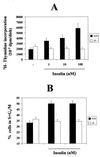Association of insulin receptor substrate 1 (IRS-1) y895 with Grb-2 mediates the insulin signaling involved in IRS-1-deficient brown adipocyte mitogenesis
- PMID: 11259577
- PMCID: PMC86861
- DOI: 10.1128/MCB.21.7.2269-2280.2001
Association of insulin receptor substrate 1 (IRS-1) y895 with Grb-2 mediates the insulin signaling involved in IRS-1-deficient brown adipocyte mitogenesis
Abstract
We have recently generated immortalized fetal brown adipocyte cell lines from insulin receptor substrate 1 (IRS-1) knockout mice and demonstrated an impairment in insulin-induced lipid synthesis as compared to wild-type cell lines. In this study, we investigated the consequences of IRS-1 deficiency on mitogenesis in response to insulin. The lack of IRS-1 resulted in the inability of insulin-stimulated IRS-1-deficient brown adipocytes to increase DNA synthesis and enter into S/G2/M phases of the cell cycle. These cells showed a severe impairment in activating mitogen-activated protein kinase kinase (MEK1/2) and p42-p44 mitogen-activated protein kinase (MAPK) upon insulin stimulation. IRS-1-deficient cells also lacked tyrosine phosphorylation of SHC and showed no SHC-Grb-2 association in response to insulin. The mitogenic response to insulin could be partially restored by enhancing IRS-2 tyrosine phosphorylation and its association with Grb-2 by inhibition of phosphatidylinositol 3-kinase activity through a feedback mechanism. Reconstitution of IRS-1-deficient brown adipocytes with wild-type IRS-1 restored insulin-induced IRS-1 and SHC tyrosine phosphorylation and IRS-1-Grb-2, IRS-1-SHC, and SHC-Grb-2 associations, leading to the activation of MAPK and enhancement of DNA synthesis. Reconstitution of IRS-1-deficient brown adipocytes with the IRS-1 mutant Tyr895Phe, which lacks IRS-1-Grb-2 binding, restored SHC-IRS-1 association and SHC-Grb-2 association. However, the lack of IRS-1-Grb-2 association impaired MAPK activation and DNA synthesis in insulin-stimulated mutant cells. These data provide strong evidence for an essential role of IRS-1 and its direct association with Grb-2 in the insulin signaling pathway leading to MAPK activation and mitogenesis in brown adipocytes.
Figures









Similar articles
-
Insulin receptor substrate (IRS) proteins IRS-1 and IRS-2 differential signaling in the insulin/insulin-like growth factor-I pathways in fetal brown adipocytes.Mol Endocrinol. 1998 May;12(5):688-97. doi: 10.1210/mend.12.5.0106. Mol Endocrinol. 1998. PMID: 9605931
-
Increased insulin sensitivity in IGF-I receptor--deficient brown adipocytes.Diabetes. 2002 Mar;51(3):743-54. doi: 10.2337/diabetes.51.3.743. Diabetes. 2002. PMID: 11872675
-
Role of IRS-3 in the insulin signaling of IRS-1-deficient brown adipocytes.J Biol Chem. 2003 Nov 14;278(46):45189-99. doi: 10.1074/jbc.M301185200. Epub 2003 Aug 27. J Biol Chem. 2003. PMID: 12944402
-
Insulin resistance induced by tumor necrosis factor-alpha in myocytes and brown adipocytes.J Anim Sci. 2008 Apr;86(14 Suppl):E94-104. doi: 10.2527/jas.2007-0462. Epub 2007 Oct 16. J Anim Sci. 2008. PMID: 17940160 Review.
-
The IRS-signalling system during insulin and cytokine action.Bioessays. 1997 Jun;19(6):491-500. doi: 10.1002/bies.950190608. Bioessays. 1997. PMID: 9204766 Review.
Cited by
-
Protein phosphatase 1 regulatory subunit 12A and catalytic subunit δ, new members in the phosphatidylinositide 3 kinase insulin-signaling pathway.J Endocrinol. 2012 Sep;214(3):437-43. doi: 10.1530/JOE-12-0145. Epub 2012 Jun 22. J Endocrinol. 2012. PMID: 22728334 Free PMC article.
-
Nerve growth factor receptor TrkA, a new receptor in insulin signaling pathway in PC12 cells.J Biol Chem. 2013 Aug 16;288(33):23807-13. doi: 10.1074/jbc.M112.436279. Epub 2013 Jun 7. J Biol Chem. 2013. PMID: 23749991 Free PMC article.
-
Reducing IRS-1 Activation Cause Mutation of Tyrosine Kinase Domain hINSR Gene on Type-2 Diabetes Mellitus Patients.Bioinformation. 2013 Oct 16;9(17):853-7. doi: 10.6026/97320630009853. eCollection 2013. Bioinformation. 2013. PMID: 24250111 Free PMC article.
-
Does reduced IGF-1R signaling in Igf1r+/- mice alter aging?PLoS One. 2011;6(11):e26891. doi: 10.1371/journal.pone.0026891. Epub 2011 Nov 23. PLoS One. 2011. PMID: 22132081 Free PMC article.
-
Silencing of insulin receptor substrate-1 increases cell death in retinal Müller cells.Mol Vis. 2012;18:271-9. Epub 2012 Feb 1. Mol Vis. 2012. PMID: 22328823 Free PMC article.
References
-
- Araki E, Lipes M A, Patti M E, Brüning J C, Haag III B L, Johnson R S, Kahn C R. Alternative pathway of insulin signalling in mice made with targeted disruption of the IRS-1 gene. Nature. 1994;372:186–190. - PubMed
-
- Baserga R. Growth regulation of the PCNA gene. J Cell Sci. 1991;98:433–436. - PubMed
-
- Bradford M. A rapid and sensitive method for the quantitation of microgram quantities of protein utilizing the principle of protein-dye binding. Anal Biochem. 1976;72:248–254. - PubMed
Publication types
MeSH terms
Substances
LinkOut - more resources
Full Text Sources
Medical
Molecular Biology Databases
Research Materials
Miscellaneous
